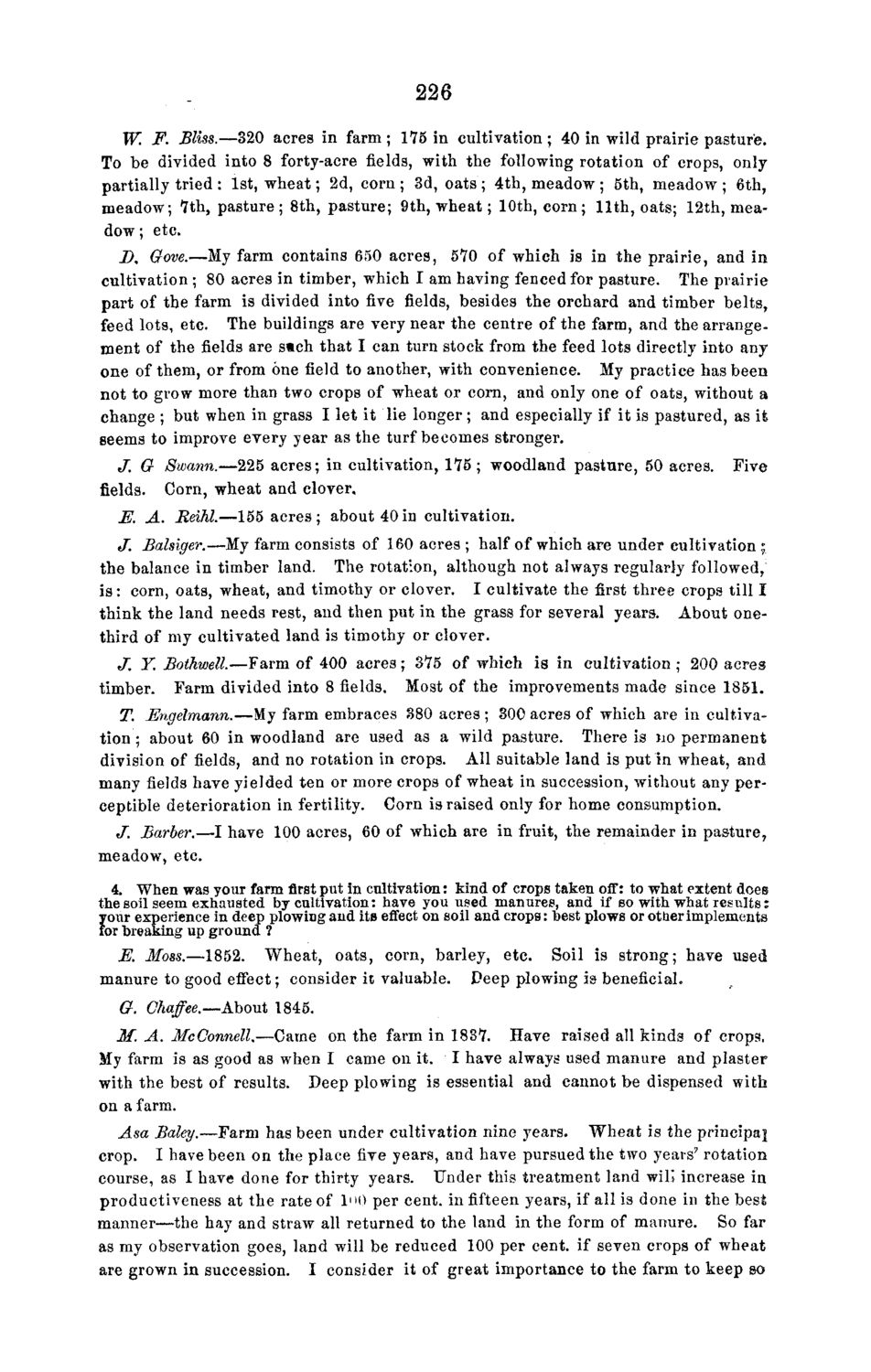| |
| |
Caption: Board of Trustees Minutes - 1868
This is a reduced-resolution page image for fast online browsing.

EXTRACTED TEXT FROM PAGE:
226 W. F. Bliss.—320 acres in farm ; 175 in cultivation ; 40 in wild prairie pasture. To be divided into 8 forty-acre fields, with the following rotation of crops, only partially tried: 1st, wheat; 2d, corn; 3d, oats; 4th, meadow; 5th, meadow; 6th, meadow; 1th, pasture ; 8th, pasture; 9th, wheat; 10th, corn; 11th, oats; 12th, meadow ; etc. D% Gove.—My farm contains 650 acres, 570 of which is in the prairie, and in cultivation ; 80 acres in timber, which I am having fenced for pasture. The prairie part of the farm is divided into five fields, besides the orchard and timber belts, feed lots, etc. The buildings are very near the centre of the farm, and the arrangement of the fields are s*ch that I can turn stock from the feed lots directly into any one of them, or from one field to another, with convenience. My practice has been not to grow more than two crops of wheat or corn, and only one of oats, without a change ; but when in grass I let it lie longer; and especially if it is pastured, as it seems to improve every year as the turf becomes stronger. J. G Swann.—225 acres; in cultivation, 175; woodland pasture, 50 acres. fields. Corn, wheat and clover, E. A. Reiki.—155 acres; about 40in cultivation. Five J. Balsiger.—My farm consists of 160 acres ; half of which are under cultivation ; the balance in timber land. The rotation, although not always regularly followed, is: corn, oats, wheat, and timothy or clover. I cultivate the first three crops till I think the land needs rest, and then put in the grass for several years. About onethird of my cultivated land is timothy or clover. J. Y. JBothwell.—Farm of 400 acres; 375 of whieh is in cultivation ; 200 acres timber. Farm divided into 8 fields. Most of the improvements made since 1851. T. Engelmann.—My farm embraces 380 acres ; 300 acres of which are in cultivation ; about 60 in woodland are used as a wild pasture. There is Jio permanent division of fields, and no rotation in crops. All suitable land is put in wheat, and many fields have yielded ten or more crops of wheat in succession, without any perceptible deterioration in fertility. Corn is raised only for home consumption. J. Barber.—I have 100 acres, 60 of which are in fruit, the remainder in pasture, meadow, etc. 4. When was your farm first put in cultivation: kind of crops taken off: to what extent does the soil seem exhausted by cultivation: have you used manures, and if so with what results: your experience in deep plowing and its effect on soil and crops: best plows or other implements for breaking up ground ? E. Moss.—1852. Wheat, oats, corn, barley, etc. Soil is strong; have used manure to good effect; consider it valuable. Deep plowing is beneficial. G. Chaffee.—About 1845. M. A. McConnell.—Came on the farm in 1887. Have raised all kinds of crops. My farm is as good as when I came on it. I have always used manure and plaster with the best of results. Deep plowing is essential and cannot be dispensed with on a farm. Asa Baley.—Farm has been under cultivation nine years. Wheat is the principal crop. I have been on the place five years, and have pursued the two years7 rotation course, as I have done for thirty years. Under this treatment land wil's increase in productiveness at the rate of 1«»0 per cent, in fifteen years, if all is done in the best manner—the hay and straw all returned to the land in the form of manure. So far as my observation goes, land will be reduced 100 per cent, if seven crops of wheat are grown in succession. I consider it of great importance to the farm to keep so
| |